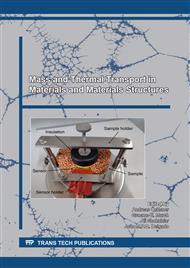[1]
J. G. Charney, On the scale of atmospheric motions, Geofys. Publ. 17 (1948) 1–17.
Google Scholar
[2]
A. Bejan, Shape and Structure, from Engineering to Nature, Cambridge University Press, Cambridge, (2000).
Google Scholar
[3]
A. Bejan, Simple methods for convection in porous media: scale analysis and the intersection of asymptotes, Int. J. Energy Res. 27 (2003) 859–874.
DOI: 10.1002/er.922
Google Scholar
[4]
D. Chandra, D. K. Ghosh, D. Sanyal, A scale analysis model for film boiling heat transfer on a vertical flat plate with wide applicability, International Journal of Heat and Mass Transfer 90 (2015) 40-48.
DOI: 10.1016/j.ijheatmasstransfer.2015.06.044
Google Scholar
[5]
M. Dzodzo, Scaling analysis and relation to EMDAP and BEPU, Nuclear Engineering and Design 353 (2019) 110228.
DOI: 10.1016/j.nucengdes.2019.110228
Google Scholar
[6]
O. Dounia, O. Vermorel, T. Jaravel, T. Poinsot, Time scale analysis of the homogeneous flame inhibition by alkali metals, Proceedings of the Combustion Institute (2020) in press.
DOI: 10.1016/j.proci.2020.06.030
Google Scholar
[7]
A. F. Miguel, Natural flow systems: acquiring their constructal morphology. International Journal of Design & Nature and Ecodynamics 5 (2010) 230-241.
DOI: 10.2495/dne-v5-n3-230-241
Google Scholar
[8]
A. Bejan, S. Lorente, Design with Constructal Theory, Wiley, Hoboken, (2008).
Google Scholar
[9]
A. F. Miguel, Constructal patterns formation in nature, pedestrian motion and epidemics propagation, in: A. Bejan, G. Merkx (Eds.), Constructal Theory of Social Dynamics, Springer, New York, 2007, pp.85-114.
DOI: 10.1007/978-0-387-47681-0_5
Google Scholar
[10]
A. Bejan, Advanced Engineering Thermodynamics, John Wiley & Sons, Hoboken, New Jersey, (2016).
Google Scholar
[11]
A. F. Miguel, A. Bejan, The principle that generates dissimilar patterns inside aggregates of organisms, Journal Physica A 388 (2009) 727-731.
DOI: 10.1016/j.physa.2008.11.013
Google Scholar
[12]
A. F. Miguel, Constructal pattern formation in stony corals, bacterial colonies and plant roots under different hydrodynamics conditions, Journal of Theoretical Biology 242 (2006) 954-961.
DOI: 10.1016/j.jtbi.2006.05.010
Google Scholar
[13]
A. F. Miguel, Constructal theory of pedestrian dynamics, Physics Letters A 373 (2009) 1734-1738.
DOI: 10.1016/j.physleta.2009.03.020
Google Scholar
[14]
A. F. Miguel, The emergence of design in pedestrian dynamics: locomotion, self-organization, walking paths and constructal law, Physics of Life Reviews 10 (2013) 168–190.
DOI: 10.1016/j.plrev.2013.03.007
Google Scholar
[15]
A. F. Miguel, Entropy generation: a path for understanding human gait patterns and crowd dynamics, International Journal of Exergy 23 (2017) 18-30.
DOI: 10.1504/ijex.2017.084519
Google Scholar
[16]
A. F. Miguel, A crowd of pedestrian dynamics – the perspective of physics, Physics of Life Review 18 (2016) 37-39.
Google Scholar
[17]
A.F. Miguel, Key mechanisms behind pedestrian dynamics: individual and collective patterns of motion, Diffusion Foundations 3 (2015) 153-164.
DOI: 10.4028/www.scientific.net/df.3.153
Google Scholar
[18]
A. F. Miguel, Physics' insights into pedestrian motion and crowd dynamics. Physics of Life Reviews 10 (2013) 206–209.
DOI: 10.1016/j.plrev.2013.05.006
Google Scholar
[19]
A. F. Miguel, A study of entropy generation in tree-shaped flow structures, International Journal of Heat and Mass Transfer 92 (2016) 349-359.
DOI: 10.1016/j.ijheatmasstransfer.2015.08.067
Google Scholar
[20]
A. F. Miguel, Toward an optimal design principle in symmetric and asymmetric tree flow networks, Journal of Theoretical Biology 389 (2016) 101-109.
DOI: 10.1016/j.jtbi.2015.10.027
Google Scholar
[21]
A. Bejan, S. Ziaei, S. Lorente, Evolution: why all plumes and jets evolve to round cross sections, Scientific Reports 4 (2014) 4730.
DOI: 10.1038/srep04730
Google Scholar
[22]
B. Soni, A. F. Miguel, A. K. Nayak, A mathematical analysis for constructal design of tree flow networks under unsteady flow, Proceedings of the Royal Society A 476 (2020) 20200377.
DOI: 10.1098/rspa.2020.0377
Google Scholar


